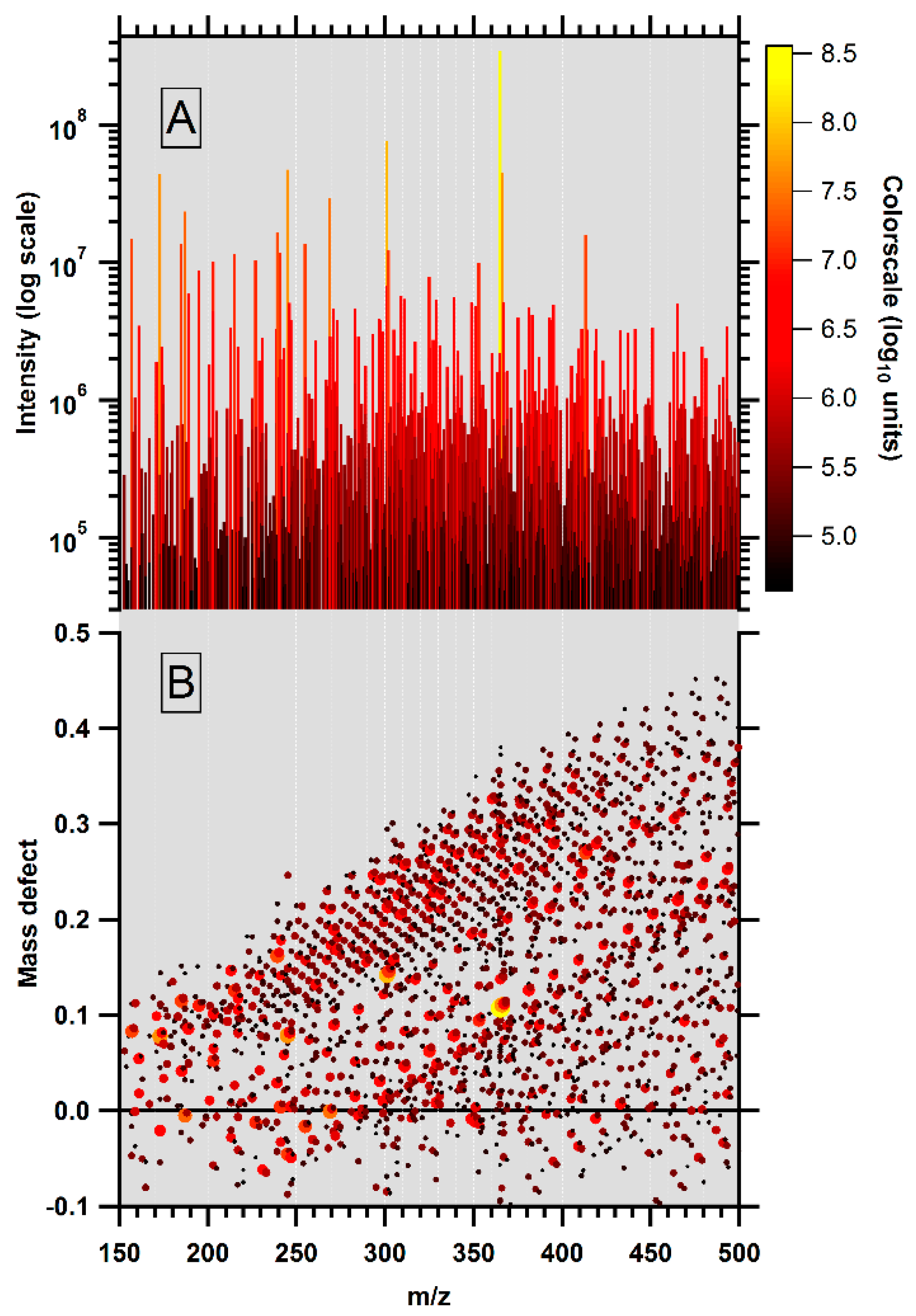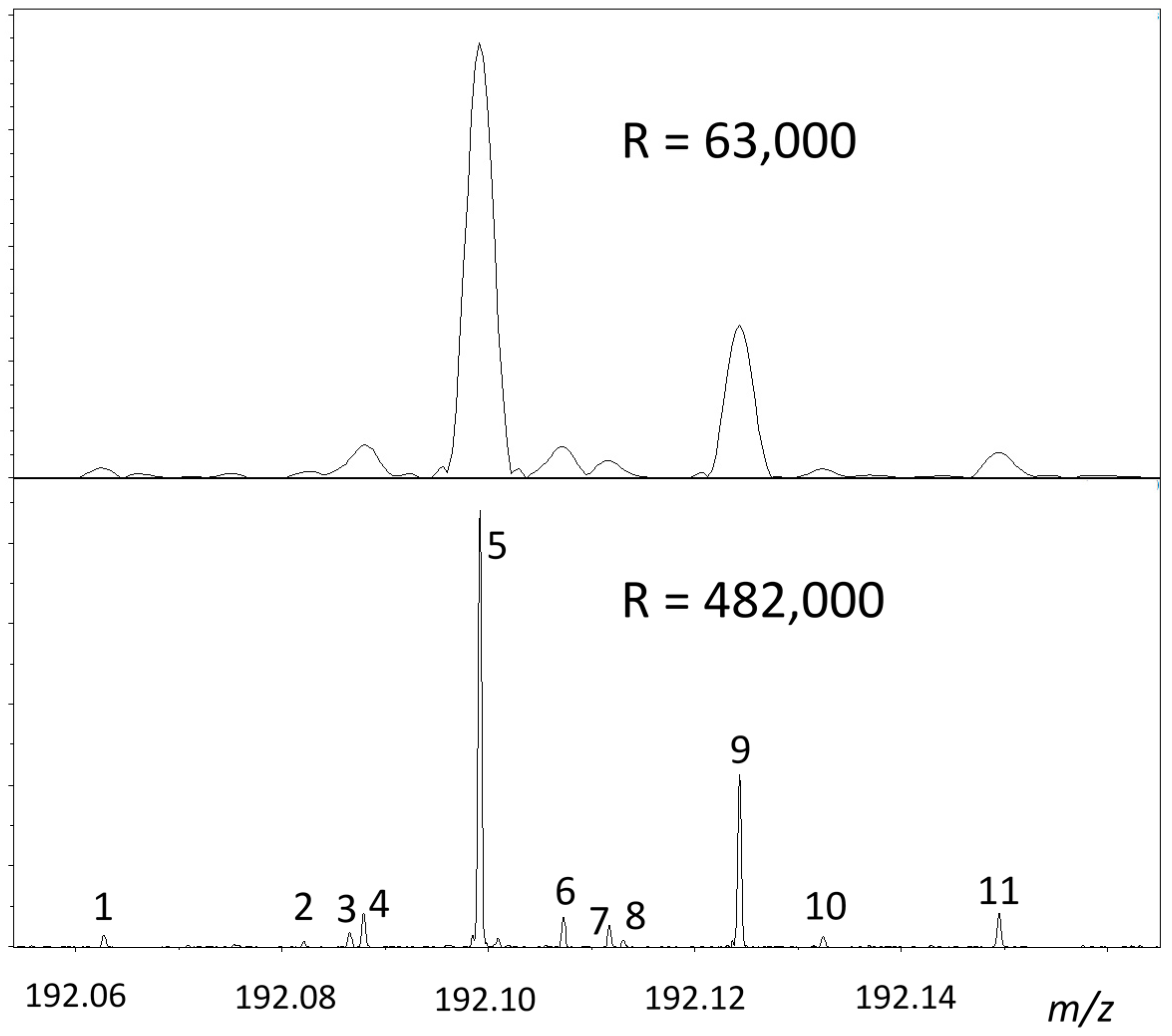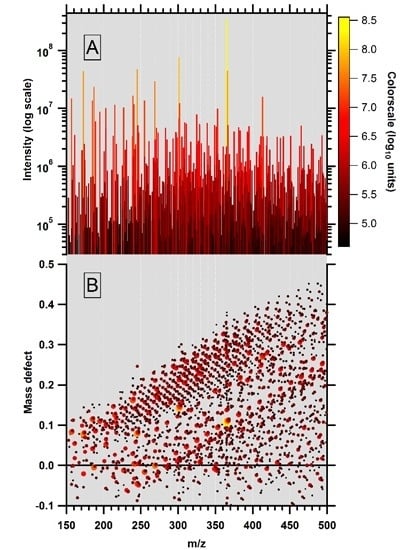The Role of Ultrahigh Resolution Fourier Transform Mass Spectrometry (FT-MS) in Astrobiology-Related Research: Analysis of Meteorites and Tholins
Abstract
:1. Introduction
2. Results and Discussion
2.1. Determination of Organic Components in Meteorites by FT-MS
2.2. Modeling Reactions in Titan’s Atmosphere and Analyzing the Products by FT-MS
2.3. Structural Analysis of Laboratory “Tholins”, Analogues of Titan Aerosols by FT-MS
3. Materials and Methods
- (i)
- To separate and determine major and minor components in complex mixtures, i.e., significantly improve the chemical information. Without ultrahigh resolution, this information would be lost.
- (ii)
- To perform accurate mass measurements (i.e., chemical composition determination) within <100 ppb error with internal calibration. Isotope fine structures [39] can be determined so that “isobaric” elements (e.g., 32S (31.972071) and 2 O (31.989829)) are distinguished and used to confirm/eliminate certain chemical compositions. It has been shown that a mass resolution of 5,000,000 and mass accuracy of 100 ppb are sufficient to unambiguously ascribe the correct elemental composition for ions containing C, H, O, N, and S up to 500 Da [40].
- (iii)
- To determine fragmentation pattern of several precursor ions, i.e., speeding up structural determination. Practically, this means data independent acquisitions (DIA) [41] that are widely used for complex metabolomics samples. Knowing the chemical compositions and characteristic fragments, e.g., loss of H2O, NH3, HCN, CH3CN, etc., one can easily generate a theoretical fragmentation matrix that can be compared to experimentally observed fragments to reveal structural features of individual components.
4. Conclusions
Acknowledgments
Author Contributions
Conflicts of Interest
References
- Ehrenfreund, P.; Spaans, M.; Holm, H.G. The evolution of organic matter in space. Philos. Trans. R. Soc. 2011, 369, 538–554. [Google Scholar]
- Irvine, W.M. Extraterrestrial organic matter. Orig. Life Evol. Bios. 1998, 28, 365–383. [Google Scholar] [CrossRef]
- Czakó, G.; Nagy, B.; Tasi, G.Y.; Somogyi, Á.; Šimunek, J.; Noga, J.; Braams, J.-B.; Bowman, J.M.; Császár, A.G. Proton affinity and enthalpy of formation of formaldehyde. Int. J. Quantum Chem. 2009, 109, 2393–2409. [Google Scholar] [CrossRef]
- Waite, J.H., Jr.; Niemann, H.B.; Yelle, R.V.; Kasprzak, W.T.; Cravens, T.E.; Luhmann, J.G.; McNutt, R.L., Jr.; Ip, W.-H.; Gell, D.; de La Haye, V.; et al. Ion neutral mass spectrometer results from the first flyby of Titan. Science 2005, 308, 982–986. [Google Scholar] [CrossRef] [PubMed]
- Cravens, T.E.; Robertson, I.P.; Waite, J.H., Jr.; Yelle, R.V.; Kasprzak, W.T.; Keller, C.N.; Ledvina, S.A.; Niemann, H.B.; Luhmann, J.G.; McNutt, R.L., Jr.; et al. Composition of Titan’s ionosphere. Geophys. Res. Lett. 2006, 33, L07105. [Google Scholar] [CrossRef]
- Waite, J.H., Jr.; Young, D.T.; Cravens, T.E.; Coates, A.J.; Crary, F.J.; Magee, B.; Westlake, J. The process of tholin formation in Titan’s upper atmosphere. Science 2007, 316, 870–875. [Google Scholar] [CrossRef] [PubMed]
- Coates, A.J.; Crary, F.; Lewis, G.; Young, D.T.; Waite, J.H., Jr.; Sittler, E.C.J. A new upper limit to the field-aligned potential near Titan. Geophys. Res. Lett. 2007, 34, L22103. [Google Scholar] [CrossRef]
- Coates, A.J.; Wellbrock, A.; Lewis, G.R.; Jones, G.H.; Young, D.T.; Crary, F.J.; Waite, J.H., Jr. Heavy negative ions in Titan’s atmosphere: Altitude and latitude dependence. Planet. Space Sci. 2009, 57, 1866–1871. [Google Scholar] [CrossRef]
- Cable, M.L.; Hörst, S.M.; Hodyss, R.; Beauchamp, P.M.; Smith, M.A.; Willis, P.A. Titan tholins: Simulating Titan organic chemistry in the Cassini-Huygens era. Chem. Rev. 2012, 112, 1882–1909. [Google Scholar] [CrossRef] [PubMed]
- Orthous-Daunay, F.-R.; Thissen, R.; Vuitton, V.; Somogyi, Á.; Mespoulede, M.; Beck, P.; Bonnet, J.-Y.; Dutuit, O.; Schmitt, B.; Quirico, E. Orbitrap-MS and FT-ICR-MS of free and labile organic matter from carbonaceous chondrites. In Proceedings of the 42nd Lunar and Planetary Science Conference, The Woodlands, TX, USA, 7–11 March 2011; p. 2654.
- Callahan, M.P.; Smith, K.E.; Cleaves, H.J., II; Ruzicka, J.; Stern, J.C.; Glavin, D.P. Carbonaceous meteorites contain a wide range of extraterrestrial nucleobases. Proc. Natl. Acad. Sci. USA 2011, 34, 13995–13998. [Google Scholar] [CrossRef] [PubMed]
- Schmitt-Kopplin, P.; Harir, M.; Kanawati, B.; Tziozis, D.; Hertkorn, N.; Gabelica, Z. Chemical footprint of the solvent soluble extraterrestrial organic matter occluded in Sołtmany ordinary chondrite. Meteorites 2012, 2, 79–92. [Google Scholar]
- Schmitt-Kopplin, P.; Gabelica, Z.; Gougeon, R.G.; Fekete, A.; Kanawati, B.; Harir, M.; Gebefuegi, I.; Eckel, G.; Hertkorn, N. High molecular diversity of extraterrestrial organic matter in Murchison meteorite revealed 40 years after its fall. Proc. Natl. Acad. Sci. USA 2010, 107, 2763–2768. [Google Scholar] [CrossRef] [PubMed]
- Saladino, R.; Carota, E.; Botta, G.; Kapralov, M.; Timoshenko, G.N.; Rozanov, I.Y.; Krasavin, E.; di Mauro, E. Meteorite-catalyzed syntheses of nucleosides and of other prebiotic compounds from formamide under proton irradiation. Proc. Natl. Acad. Sci. USA 2015, 112, E2746–E2755. [Google Scholar] [CrossRef] [PubMed]
- Vuitton, V.; Yelle, R.V.; McEwan, M.J. Ion chemistry and N-containing molecules in Titan’s upper atmosphere. Icarus 2007, 191, 722–742. [Google Scholar] [CrossRef]
- Yelle, R.V.; Vuitton, V.; Lavvas, P.; Klippenstein, S.S.; Smith, M.A.; Hörst, S.M.; Cui, J. Formation of NH3 and CH2NH in Titan’s upper atmosphere. Faraday Discuss. 2010, 147, 31–49. [Google Scholar] [CrossRef] [PubMed]
- Lavvas, P.; Yelle, R.V.; Vuitton, V. The detached haze layer in Titan’s mesosphere. Icarus 2009, 201, 626–633. [Google Scholar] [CrossRef]
- Lebonnois, S.; Bakes, E.L.O.; McKay, C.P. Transition from gaseous compounds to aerosols in Titan’s atmosphere. Icarus 2002, 159, 505–517. [Google Scholar] [CrossRef]
- Magee, B.A.; Waite, J.; Mandt, K.E.; Westlake, J.; Bell, J.; Gell, D.A. INMS-derived composition of Titan’s upper atmosphere: Analysis methods and model comparison. Planet. Space Sci. 2009, 57, 1895–1916. [Google Scholar] [CrossRef]
- Imanaka, H.; Smith, M.A. Formation of nitrogenated organic aerosols in the Titan upper atmosphere. Proc. Natl. Acad. Sci. USA 2010, 107, 12423–12428. [Google Scholar] [CrossRef] [PubMed]
- Somogyi, Á. Probing peptide fragment ion structures by combining sustained off-resonance collision-induced dissociation and gas-phase H/D exchange (SORI-HDX) in fourier transform ion-cyclotron resonance (FT-ICR) instruments. J. Am. Soc. Mass Spectrom. 2008, 19, 1771–1775. [Google Scholar] [CrossRef] [PubMed]
- Somogyi, Á.; Harrison, A.G.; Paizs, B. Using gas-phase guest-host chemistry to probe the structures of b ions of peptides. J. Am. Soc. Mass Spectrom. 2012, 23, 2055–2058. [Google Scholar] [CrossRef] [PubMed]
- Thissen, R.; Vuitton, V.; Lavvas, P.; Lemaire, J.; Dehon, C.; Dutuit, O.; Smith, M.A.; Turchini, S.; Catone, D.; Yelle, R.V.; et al. Laboratory studies of molecular growth in the Titan ionosphere. Phys. Chem. A 2009, 113, 11211–11220. [Google Scholar] [CrossRef] [PubMed]
- Sharker, N.; Somogyi, Á.; Lunine, J.I.; Smith, M.A. Titan aerosol analogues: Analysis of the nonvolatile tholins. Astrobiology 2003, 3, 719–726. [Google Scholar] [CrossRef] [PubMed]
- Somogyi, Á.; Smith, M.A.; Vuitton, V.; Thissen, R.; Komáromi, I. Chemical ionization in the atmosphere? A model study on negatively charged “exotic” ions generated from Titan’s tholins by ultrahigh resolution MS and MS/MS. Int. J. Mass Spectrom. 2012, 316–318, 157–163. [Google Scholar] [CrossRef]
- Pernot, P.; Carrasco, N.; Thissen, R.; Schmitz-Afonso, I. Tholinomics-chemical analysis of nitrogen-rich polymers. Anal. Chem. 2010, 82, 1371–1380. [Google Scholar] [CrossRef] [PubMed]
- Hörst, S.M.; Yelle, R.V.; Buch, A.; Carrasco, N.; Cernogora, G.; Dutuit, O.; Quirico, E.; Sciamma-O’Brien, E.; Smith, M.A.; Somogyi, Á.; et al. Formation of prebiotic molecules in a Titan atmosphere simulation experiment. Astrobiology 2012, 12, 809–817. [Google Scholar] [CrossRef] [PubMed]
- Szopa, C.; Cernogora, G.; Boufendi, L.; Correia, J.-J.; Coll, P. PAMPRE: A dusty plasma experiment for Titan’s tholins production and study. Planet. Space Sci. 2006, 54, 394–404. [Google Scholar] [CrossRef]
- Somogyi, Á.; Oh, C.-H.; Lunine, J.I.; Smith, M.A. Organic environments on Saturn’s moon, Titan: Simulating chemical reactions and analyzing products by FT-ICR and ion-trap mass spectrometry. J. Am. Soc. Mass Spectrom. 2005, 16, 850–859. [Google Scholar] [CrossRef] [PubMed]
- Neish, C.D.; Somogyi, Á.; Imanaka, H.; Lunine, J.I.; Smith, M.A. Rate measurements of the hydrolysis of complex macromolecules in cold aqueous solutions: Implications for prebiotic chemistry on the early Earth and Titan. Astrobiology 2008, 8, 273–287. [Google Scholar] [CrossRef] [PubMed]
- Neish, C.D.; Somogyi, Á.; Lunine, J.I.; Smith, M.A. Low temperature hydrolysis of laboratory tholins in ammonia-water solutions: Implications for prebiotic chemistry on Titan. Icarus 2009, 201, 412–421. [Google Scholar] [CrossRef]
- Neish, C.D.; Somogyi, Á.; Smith, M.A. Titan’s primordial soup: Formation of amino acids via low-temperature hydrolysis of tholins. Astrobiology 2010, 10, 337–347. [Google Scholar] [CrossRef] [PubMed]
- Carrasco, N.; Schmitz-Afonso, I.; Bonnet, J.-Y.; Quirico, E.; Thissen, R.; Dutuit, O.; Bagag, A.; Laprévote, O.; Bush, A.; Giulani, A.; et al. Chemical characterization of Titan’s tholins: Solubility, morphology and molecular structure revisited. J. Phys. Chem. A 2009, 113, 11195–11203. [Google Scholar] [CrossRef] [PubMed]
- De Marcellus, P.; Meinert, C.; Myrgorodska, I.; Nahon, L.; Buhse, T.; Le Sergeant d’Hendecourt, L.; Meierhenrich, U.J. Aldehydes and sugars from evolved precometary ice analogs: Importance of ices in astrochemical and prebiotic evolution. Proc. Natl. Acad. Sci. USA 2015, 112, 965–970. [Google Scholar] [CrossRef] [PubMed]
- Lemaire, J.; Boissel, P.; Heninger, M.; Mauclaire, G.; Bellec, G.; Mestdagh, H.; Simon, A.; le Caer, S.; Ortega, J.M.; Glotin, F.; et al. Gas Phase infrared spectroscopy of selectively prepared ions. Phys. Rev. Lett. 2002, 89, 273002. [Google Scholar] [CrossRef] [PubMed]
- Makarov, A.; Denisov, E.; Kolomeev, A.; Balschun, W.; Lange, O.; Strupat, K.; Horning, S. Performance evaluation of a hybrid linear ion trap/orbitrap mass spectrometer. Anal. Chem. 2006, 78, 2113–2120. [Google Scholar] [CrossRef] [PubMed]
- Hendrickson, C.L.; Quinn, J.P.; Kaiser, N.K.; Smith, D.F.; Blakney, G.T.; Chen, T.; Marshall, A.G.; Weisbrod, C.R.; Beu, S.C. 21 Tesla fourier transform ion cyclotron resonance mass spectrometer: A national resource for ultrahigh resolution mass analysis. J. Am. Soc. Mass Spectrom. 2015, 26, 1626–1632. [Google Scholar] [CrossRef] [PubMed]
- Kostyukevich, Y.I.; Vladimirov, G.N.; Nikolaev, E.N. Dynamically harmonized FT-ICR cell with specially shaped electrodes for compensation of inhomogeneity of the magnetic field. computer simulations of the electric field and ion motion dynamics. J. Am. Soc. Mass Spectrom. 2013, 23, 2198–2207. [Google Scholar] [CrossRef] [PubMed]
- Loos, M.; Gerber, C.; Corona, F.; Hollender, J.; Singer, H. Accelerated isotope fine structure calculation using pruned transition trees. Anal. Chem. 2015, 87, 5738–5744. [Google Scholar] [CrossRef] [PubMed]
- Kim, S.; Rogers, R.P.; Marshall, A.G. Truly “exact” mass: Elemental composition can be determined uniquely from molecular mass measurement at ≈0.1 mDa accuracy for molecules up the ≈500 Da. Int. J. Mass Spectrom. 2006, 251, 260–265. [Google Scholar] [CrossRef]
- Doerr, A. DIA mass spectrometry. Nat. Methods 2015, 12, 35. [Google Scholar] [CrossRef]
- Kendrick, E. A Mass scale based on CH2=14.000 for high resolution mass spectrometry of organic compounds. Anal. Chem. 1963, 35, 2146–2154. [Google Scholar] [CrossRef]
- Danger, G.; Orthous-Daunay, F.-R.; de Marcellus, P.; Modica, P.; Vuitton, V.; Duvernay, F.; Flandinet, L.; d’Hendecourt, L.L.; Thissen, R.; Chiavassa, T. Characterization of laboratory analogs of interstellar/cometary organic residues using very high resolution mass spectrometry. Geochim. Cosmochim. Acta 2013, 118, 184–201. [Google Scholar] [CrossRef]
- Van Krevelen, D.W. Graphical-statistical method for the study of structure and reaction process of coal. Fuel 1950, 29, 269–284. [Google Scholar]
- Kim, S.; Kramer, R.W.; Hatcher, P.G. Graphical method for analysis of ultrahigh-resolution broadband mass spectra of natural organic matter, the van Krevelen diagram. Anal. Chem. 2003, 75, 5336–5344. [Google Scholar] [CrossRef] [PubMed]
- Kumenkov, E.V.; Kononikhin, A.S.; Perminova, R.V.; Hertkorn, N.; Gaspar, A.; Schmitt-Kopplin, P.; Popov, I.A.; Garmash, A.V.; Nikolaev, E.N. Total mass difference statistics algorithm: A new approach to identification of high-mass building blocks in electrospray ionization Fourier transform ion cyclotron mass spectrometry data of natural organic matter. Anal. Chem. 2009, 81, 10106–10115. [Google Scholar] [CrossRef] [PubMed]
- Hässig, M.; Libardoni, M.; Mandt, K.; Miller, G.; Blasé, R. Performance evaluation of a prototype multi-bounce time-of-flight mass spectrometer in linear mode and applications in space science. Planet Space Sci. 2015, 117, 436–443. [Google Scholar] [CrossRef]
- Briois, C.; Lethuillier, A.; Thirkell, L.; Boukrara, A.; Lebreton, J.-P.; Carrasco, N.; Szopa, C.; Chapuis, C.; Bouabdellah, A.; Thissen, R.; et al. A high mass-resolution orbitrap mass spectrometer for in Situ analysis in planetary science. In Proceedings of the JFSM Conference, Orléans, France, 17–20 September 2012.
- Briois, C.; Lebreton, J.-P.; Szopa, C.; Thirkell, L.; Aradj, K.; Bouabdellah, A.; Boukrara, A.; Carrasco, N.; Chalumeau, G.; Chapelon, O.; et al. High resolution mass spectrometry for future space instrumentation: Current development within the french space orbitrap consortium. In Proceedings of the Geophysical Research, 16 2014 EGU2014-1639, Vienna, Austria, 27 April–2 May 2014.
- Carrasco, N.; Szopa, C.; Chapuis, C.; Bouabdellah, A.; Thissen, R.; Cornelli, S.; Puget, P.; Briois, C.; Thirkell, L.; Boukrara, A.; et al. Ultra high mass-resolution for space exploration: The orbitrap mass analyzer. In Proceedings of the EPSC 2012, Madrid, Spain, 23–28 September 2012.
- Thissen, R.; Thirkell, L.; Makarov, A.; Puget, P.; Briois, C.; Szopa, C.; Carrasco, N.; Berthelier, J.-J.; Cottin, H.; Grand, N.; et al. Ultrahigh resolution fourier transform mass analyzer for space exploration: Orbitrap. In Proceedings of the DPS-EPSC 2011, Nantes, France, 2–7 October 2011.
- Vuitton, V.; Briois, C.; Thirkell, L.; Aradj, K.; Bouabdellah, A.; Boukrara, A.; Carrasco, N.; Chalumeau, G.; Chapelon, O.; Colin, F.; et al. The orbitrap mass analyzer as a space instrument for the understanding of prebiotic chemistry in the solar system. In Proceedings of the 40th COSPAR Scientific Assembly, Moscow, Russia, 2–10 August 2014.
- Kempf, S.; Srama, R.; Grün, E.; Mocker, A.; Postberg, F.; Hillier, J.K.; Horany, M.; Sternovsky, Z.; Abel, B.; Beinsen, A.; et al. Linear high resolution dust mass spectrometer for a mission to the Galilean satellites. Planet. Space Sci. 2012, 65, 10–20. [Google Scholar] [CrossRef]





| Peak | Ionic Composition * | Calculated m/z | Measured m/z |
|---|---|---|---|
| 1 | C6H6N7O | 192.06283 | 192.06282 |
| 2 | C6H7N8 (13C) | 192.08217 | 192.08218 |
| 3 | C6H8N8 | 192.08664 | 192.08657 |
| 4 | C8H10N5O | 192.08799 | 192.08799 |
| 5 | C7H10N7 * | 192.09922 | 192.09922 |
| 6 | C8H11N6 (13C) | 192.10733 | 192.10732 |
| 7 | C8H12N6 | 192.11180 | 192.11179 |
| 8 | C10H14N3O | 192.11314 | 192.11311 |
| 9 | C9H14N5 | 192.12437 | 192.12437 |
| 10 | C10H15N4 (13C) | 192.13248 | 192.13248 |
| 11 | C11H18N3 | 192.14952 | 192.14952 |
© 2016 by the authors; licensee MDPI, Basel, Switzerland. This article is an open access article distributed under the terms and conditions of the Creative Commons by Attribution (CC-BY) license (http://creativecommons.org/licenses/by/4.0/).
Share and Cite
Somogyi, Á.; Thissen, R.; Orthous-Daunay, F.-R.; Vuitton, V. The Role of Ultrahigh Resolution Fourier Transform Mass Spectrometry (FT-MS) in Astrobiology-Related Research: Analysis of Meteorites and Tholins. Int. J. Mol. Sci. 2016, 17, 439. https://doi.org/10.3390/ijms17040439
Somogyi Á, Thissen R, Orthous-Daunay F-R, Vuitton V. The Role of Ultrahigh Resolution Fourier Transform Mass Spectrometry (FT-MS) in Astrobiology-Related Research: Analysis of Meteorites and Tholins. International Journal of Molecular Sciences. 2016; 17(4):439. https://doi.org/10.3390/ijms17040439
Chicago/Turabian StyleSomogyi, Árpád, Roland Thissen, Francois-Régis Orthous-Daunay, and Véronique Vuitton. 2016. "The Role of Ultrahigh Resolution Fourier Transform Mass Spectrometry (FT-MS) in Astrobiology-Related Research: Analysis of Meteorites and Tholins" International Journal of Molecular Sciences 17, no. 4: 439. https://doi.org/10.3390/ijms17040439






